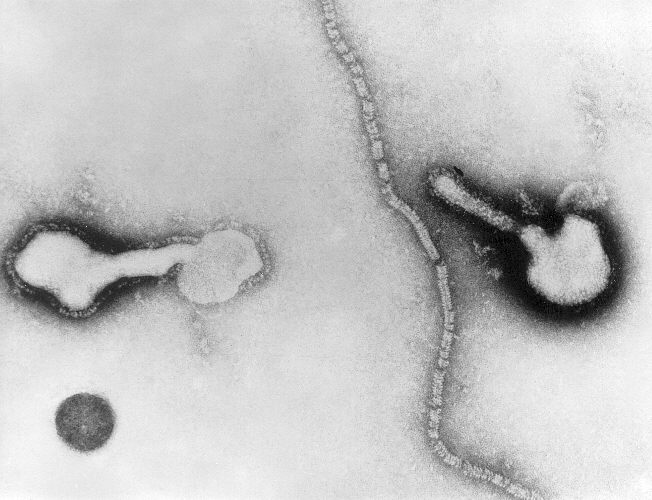Human Parainfluenza Viruses ((HPIVs) is a common and recurrent cause of respiratory illness. Croup is a prominent syndrome in children, but the spectrum of illness varies from the common cold to pneumonia and systemic illness.
Etiology.
Parainfluenza viruses are members of the myxovirus family. They closely resemble influenza virus but differ from it serologically and in some biologic respects. Four distinct types of parainfluenza viruses are recognized that cause infections in man. They are closely related to one another and have some characteristics in common with mumps, measles, and respiratory syncytial virus. Types 2 and 4 differ somewhat from types 1 and 3 in the clinical illnesses produced and in their epidemiology.
Parainfluenza viruses were first designated as hemadsorption or HA viruses, owing to their property of causing erythrocytes to adsorb and stick to infected cells in tissue cultures. In early nomenclature, type 1 was identified as HA 2 and type 3.
A parainfluenza type 1, the Sendai virus, was first isolated in mice. It was also called influenza D. Mice and other rodents were then recognized to have natural infection with parainfluenza viruses. The Sendai and other animal strains of parainfluenza type 1 have some slight serologic differences from strains of human origin. A simian myxovirus (SV-5) is commonly found in monkey kidney tissue cultures, occasionally in eggs and other tissues, ft resembles parainfluenza type 2; virus isolates from cattle with shipping fever (SF-4) were found to be parainfluenza type 3.
Incidence and Epidemiology Of Human Parainfluenza Viruses .
Few, if any, persons escape infection and reinfection with the different types of parainfluenza viruses. Most children develop antibody from infection with parainfluenza type 3 before the age of four years. By the time they enter school, 70 per cent of children have antibody against more than one type. Among older children and adults, nasopharyngeal reinfection with types 1 and 3 is common regardless of the presence of serum antibody. Reinfection with parainfluenza viruses accounts for an appreciable proportion of common colds and upper respiratory illnesses in adults.
Parainfluenza types 1 and 3 are endemic and cause illness in all seasons of the year. They also cause epidemics of respiratory disease in the winter season. Type 3 virus spreads easily from person to person. It infects virtually all contacts who have no antibody and reinfects many persons with a demonstrable level of antibody in the serum. Type 1 virus does not spread as efficiently as type 3, but is. nevertheless highly transmissible. Type 2 infection has been, less prevalent and more episodic in its occurrence than either types 1 or 3. Only about one half of susceptible persons become infected. and reinfection is not common. Infections caused by type 4 have been entirely sporadic.
Although many animal species have a high incidence of infection with the parainfluenza viruses, spread to man from these sources has not been well established.
Human Parainfluenza Viruses Clinical Manifestations.
The clinical syndrome of croup in children is the most common characteristic of infection with parainfluenza virus. Types 1 and 2 cause croup in a greater proportion of the infections than parainfluenza 3. The latter infections may be symptomatically more severe and cause more lower respiratory tract disease. Together the parainfluenza viruses account for one third to one half of the cases of severe croup in children. Although croup is the most distinctive syndrome, parainfluenza virus infections cause rhinitis or pharyngitis about twice as often as croup, and bronchitis, bronchiolitis, or pneumonia about as frequently as croup.
The initial infection with parainfluenza viruses produces more severe disease than reinfection. Among adults, parainfluenza viruses cause upper common cold. In dual viral infections, a parainfluenza virus has been recognized as a common member of the pair, with a resultant increase in the severity of the symptoms.
Diagnosis.
Clinical differentiation of the type of parainfluenza viral infection and even the differentiation from other viral infections of the respiratory tract cannot be made with confidence. The virus can be isolated from nasopharyngeal secretions during the illness and for a brief period thereafter. This is the most certain and may be the only way to identify the specific type of parainfluenza virus involved. Serologic responses are often heterotypic owing to the nearly universal infection of persons with type 3 early in life and the common infection with types 1, 2, and mumps viruses. A rise in antibody against one of these viruses does not permit confidence in a strain- specific diagnosis.
Parainfluenza Treatment.
The treatment is supportive, as described for the common cold. The croup syndrome may be very acute, and may cause respiratory insufficiency requiring urgent and decisive management. A comfortably warm, draft-free environment with high humidity (steam) may be successful in reducing laryngeal stridor. Vaccines have been produced for types 1, 2, and 3, and their antigenicity has been shown. Studies of the effectiveness of the vaccines in the prevention of natural infection are being made.
